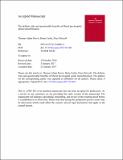Files in this item
The definite risks and questionable benefits of liberal pre-hospital spinal immobilisation
Item metadata
| dc.contributor.author | Purvis, Thomas Adam | |
| dc.contributor.author | Carlin, Brian | |
| dc.contributor.author | Driscoll, Peter | |
| dc.date.accessioned | 2018-01-27T00:31:30Z | |
| dc.date.available | 2018-01-27T00:31:30Z | |
| dc.date.issued | 2017-06 | |
| dc.identifier | 249004743 | |
| dc.identifier | c6dbf6a9-35fa-4a9a-aa76-fa5e65ccdbbd | |
| dc.identifier | 85011423355 | |
| dc.identifier | 000405291000009 | |
| dc.identifier.citation | Purvis , T A , Carlin , B & Driscoll , P 2017 , ' The definite risks and questionable benefits of liberal pre-hospital spinal immobilisation ' , The American Journal of Emergency Medicine , vol. 35 , no. 6 , pp. 860-866 . https://doi.org/10.1016/j.ajem.2017.01.045 | en |
| dc.identifier.issn | 0735-6757 | |
| dc.identifier.other | RIS: urn:E2E62CBDE5B34C02A6873B4A7E113DB2 | |
| dc.identifier.uri | https://hdl.handle.net/10023/12623 | |
| dc.description.abstract | Introduction : The routine practice of pre-hospital spinal immobilisation (phSI) for patients with suspected spinal injury has existed for decades. However, the controversy surrounding it resulted in the 2013 publication of a Consensus document by the Faculty of Pre-Hospital Care. The question remains as to whether the quality of evidence in the literature is sufficient to support the Consensus guidelines. This critical review aims to determine the validity of current recommendations by balancing the potential benefits and side effects of phSI. Method: A review of the literature was carried out by two independent assessors using Medline, PubMed, EMBASE and the Cochrane Library databases. Manual searches of related journals and reference lists were also completed. The selected body of evidence was subsequently appraised using a checklist derived from SIGN and CASP guidelines, as well as Crombie's guide to critical appraisal. Results: No reliable sources were found proving the benefit for patient immobilisation. In contrast there is strong evidence to show that pre-hospital spinal immobilisation is not benign with recognised complications ranging from discomfort to significant physiological compromise. The published literature supports the Consensus guideline recommendations for safely reducing the impact of these side effects without compromising the patient. Conclusion: The literature supports the Consensus Guidelines but raises the question as to whether they go far enough as there is strong evidence to suggest phSI is an inherently harmful procedure without having any proven benefit. These results demonstrate an urgent need for further studies to determine its treatment effect. | |
| dc.format.extent | 7 | |
| dc.format.extent | 800214 | |
| dc.language.iso | eng | |
| dc.relation.ispartof | The American Journal of Emergency Medicine | en |
| dc.subject | Immobilisation | en |
| dc.subject | Spinal injuries | en |
| dc.subject | Spinal cord injuries | en |
| dc.subject | Emergency medical services | en |
| dc.subject | RA0421 Public health. Hygiene. Preventive Medicine | en |
| dc.subject | DAS | en |
| dc.subject | SDG 3 - Good Health and Well-being | en |
| dc.subject.lcc | RA0421 | en |
| dc.title | The definite risks and questionable benefits of liberal pre-hospital spinal immobilisation | en |
| dc.type | Journal article | en |
| dc.contributor.institution | University of St Andrews. School of Medicine | en |
| dc.identifier.doi | https://doi.org/10.1016/j.ajem.2017.01.045 | |
| dc.description.status | Peer reviewed | en |
| dc.date.embargoedUntil | 2018-01-26 | |
| dc.identifier.url | http://www.sciencedirect.com/science/article/pii/S0735675717300633?via%3Dihub#s0120 | en |
This item appears in the following Collection(s)
Items in the St Andrews Research Repository are protected by copyright, with all rights reserved, unless otherwise indicated.

